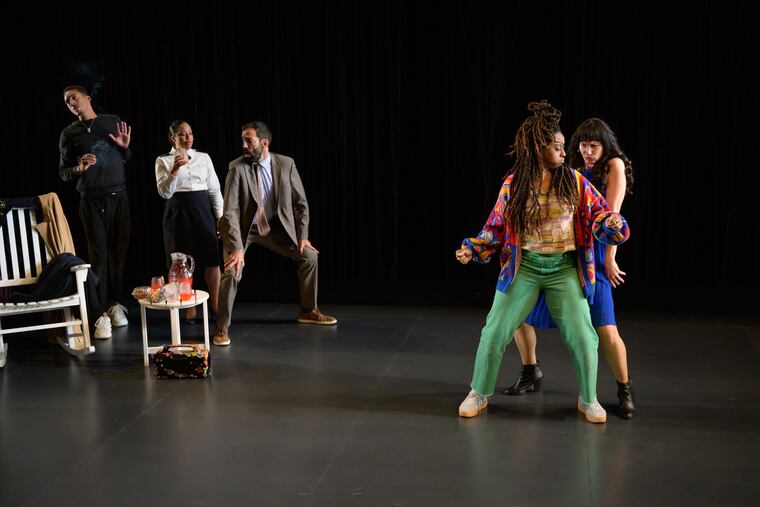‘The Comeuppance’ at the Wilma is a probable antidote to our existential dread
Lurking under Death's shadows, the play brings the drama of diverging politics and experiences to a microscopic, interpersonal level

Old friends meet up to pregame before their 20th high school reunion: What could possibly go wrong?
Jungle juice adds gasoline to the fire as old scars, crushes, and conflicting recollections of the past resurface in The Comeuppance by Branden Jacobs-Jenkins, directed by Morgan Green, a coproduction of the Wilma and D.C.’s Woolly Mammoth.
The Comeuppance captures the existential dread and melancholy of approaching early middle age. What the Germans would call torschlusspanik — the panic of opportunities closing — as Emilio (Jordan Bellow) tells Ursula (Alana Raquel Bowers), the host of the party while they wait for the others to arrive. Emilio is a dour, judgmental, and elusive artist who has spent most of the intervening years in Berlin. Ursula has lost the most during COVID-19 — first her grandmother who raised her, then her sight in one eye due to diabetes.
As more friends arrive, Emilio seems unable to stop picking fights with everyone, but especially Katelyn (Sarah Gliko), a homemaker married to a much older man who was involved in Jan. 6’s storming of the U.S. Capitol. Kristina (Taysha Marie Canales), who spent her “entire 20s either pregnant or in med school,” is an anesthesiologist with a drinking problem. Tensions reach a high point with the addition of Paco (Jaime Maseda), Katelyn’s high school boyfriend, a war veteran who suffers from PTSD.
Death, the omniscient narrator, sets the tone with its commentary on the human condition, accompanied by some snark and a love for gossip. No one actor plays Death, but it takes turns inhabiting each character, revealing their trauma and internal turmoil. Among an excellent ensemble, Bowers shines in her absurd, unhinged portrayal of Death, a foil to her understated, peacemaker character.
Minimalist set design by Jian Jung features a single rocking chair, a side table, and several layers of fringe curtains in the background. This becomes a veil for Death to peek through, and a backdrop for the happenings inside Ursula’s house. Lighting design by Minjoo Kim complements this, with disconcerting lights piercing into the eyes of the audience in the scenes with Death. Sound design by Jordan McCree bolsters the dramatics of Death, with a slight echo and vibrations.
The Comeuppance brings the drama of diverging politics and experiences to a microscopic, interpersonal level. Emilio, who has left-leaning politics, is constantly snubbing Katelyn and Paco, whom he calls not a hero, but simply an “employee” of the U.S. military industrial complex. No one character is a hero, as each of them wins our empathy, especially when possessed by Death, and then loses it. The play holds a mirror to the audience and makes them confront their own biases, assumptions, and judgment.
The Comeuppance is a must-see for anyone feeling the existential dread brought upon by their own mortality or the recent election results. It invites us to see the humanity in those whose lives or political opinions don’t align with ours.
The Comeuppance
(Community/Arts) Lurking under Death’s shadows, the play brings the drama of diverging politics and experiences to a microscopic, interpersonal level. Running time: 2 hours 20 minutes.
⌚️ Through Dec. 14 at the Wilma Theater, 📍265 S. Broad St., Phila.; 🌐 wilmatheater.org
Theater reviews are produced independently by The Inquirer without editorial input by their sponsor, Visit Philadelphia.